7.1 Classical Conditioning
As you experience the world, one event often signals the occurrence of another. A flashing light in your rearview mirror signals that a police officer may pull you over. A ringing phone in the middle of the night signals that there may be a family emergency. Once you learn the connection between the first event and the second, your reaction to the first one changes. You may react anxiously to the flashing light and the ringing phone—
Classical Conditioning in Everyday Life
Preview Question
Question
 What is an example of classical conditioning in everyday life?
What is an example of classical conditioning in everyday life?
You’re already familiar with classical conditioning from everyday life. You’ve seen people’s reaction to a stimulus change once they learn that it predicts a second stimulus. Here are some examples.
Suppose a child hears a parent address her by her full name rather than a nickname—
Classical conditioning also can produce positive emotions. Imagine that you hear a musical jingle in the distance outside your window. Soon afterward, an ice cream truck, the source of the jingle, pulls up in front of your house. Once you learn to associate the distant jingle with the subsequent arrival of ice cream, you will (if you’re an ice cream lover) come to like the jingle.
Classical conditioning can change your reactions not only to specific sights and sounds (e.g., the jingle), but also to types of people and places. Suppose you once experienced the breakup of a relationship while visiting an amusement park. In the future, you might find amusement parks less amusing than you used to because you associate them with the breakup. Your emotional reaction to a type of situation, amusement parks, changes as a result of learning through classical conditioning. In this chapter’s opening story, you saw how a boy’s reactions to a type of object, buttons, changed after a frightening experience. That change was a case of classical conditioning.
How, exactly, does classical conditioning work? As you’ve seen elsewhere in this book, the question can be answered at different levels of analysis. Let’s first look at psychological processes in classical conditioning. Then we’ll move to a biological level of analysis, examining brain mechanisms that underlie this form of learning.

WHAT DO YOU KNOW?…
Question 1
If you were to learn that the sound of a dentist drill predicted pain, your to the sound of that drill would change.
Pavlov and the Psychology of Classical Conditioning
Preview Question
Question
 In classical conditioning, what is the association that an animal learns?
In classical conditioning, what is the association that an animal learns?
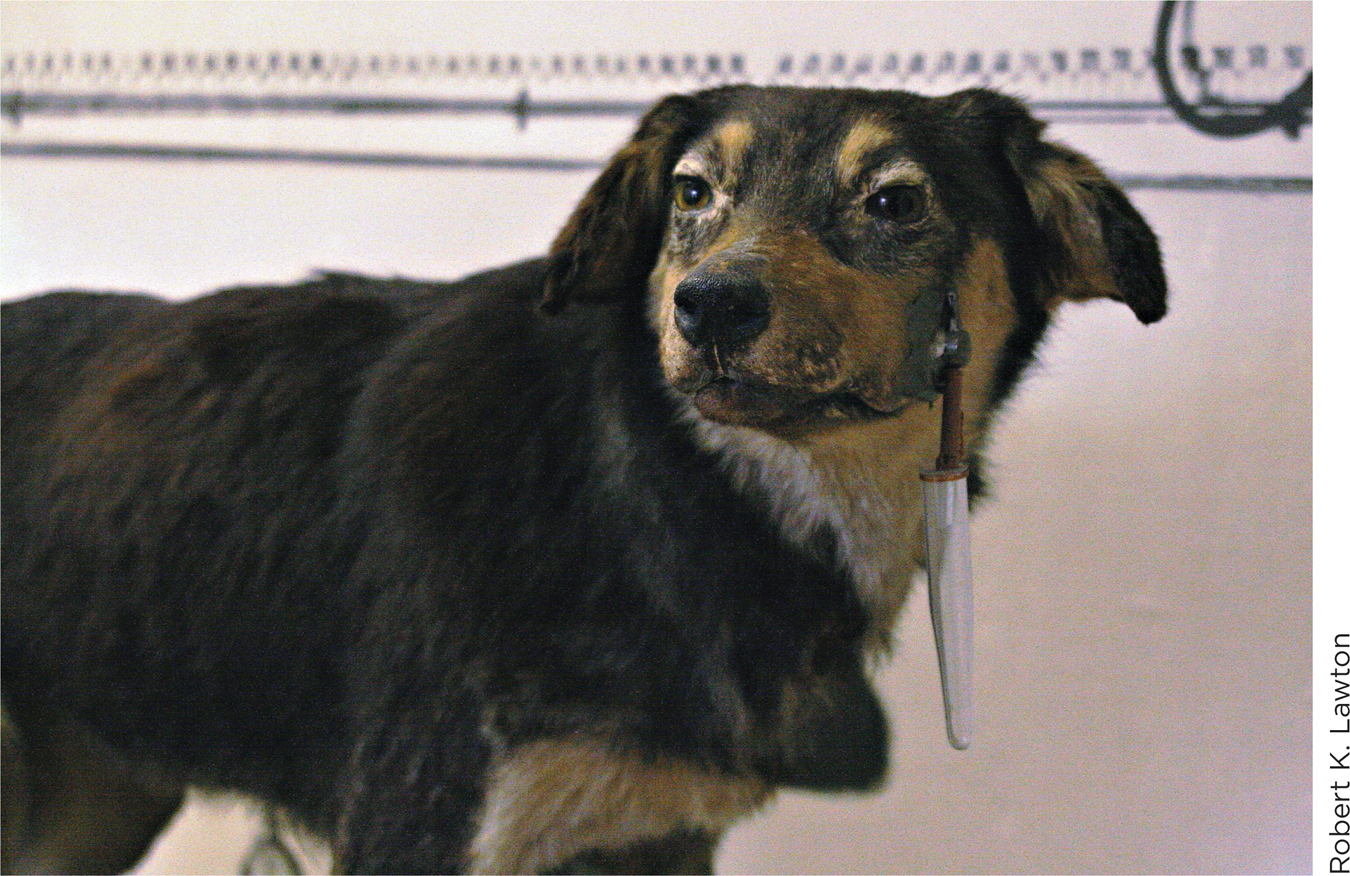
The Russian biologist Ivan Pavlov (1849–
PHYSIOLOGICAL REACTIONS TO PSYCHOLOGICAL STIMULI. While studying this biological process, Pavlov noticed something of psychological interest. Sometimes dogs salivated when no physical stimuli were in their mouths. After a few days in the lab, a dog might salivate when it heard the footsteps of a laboratory assistant who previously had brought it food.
Pavlov knew that no natural, inherited connection existed between the sound of footsteps and salivation. There was, however, a learned connection. The dogs learned that the sound of footsteps predicted the arrival of food. Once they did so, they began responding reflexively to the sound, which triggered the physiological response, salivation.
If you’re a pet owner, you probably have noticed this sort of learning yourself. Your dog may react excitedly not only when it sees dog food, but when it sees you open the cabinet door where you store her food. If so, your dog has learned that the open door signals that soon she’ll be dining.
Pavlov devised a research procedure to discover the exact processes through which animals learn to associate different types of stimuli. Let’s examine his classic procedures in detail.
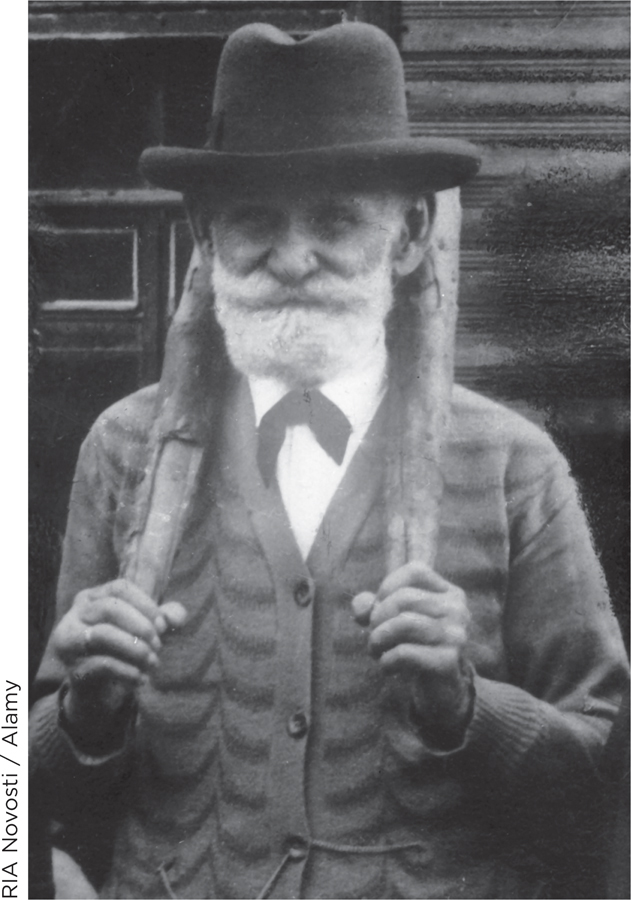
STIMULUS–
An unconditioned stimulus (US) is one that elicits a reaction in an organism prior to any learning. The reaction it elicits is called an unconditioned response (UR). For example, if a sudden and very loud noise occurs in front of you, you will startle: Your head will jerk back and your hands will move up in the air. You do not have to learn to startle; the startle response occurs the first time you ever encounter the loud noise (Quevedo et al., 2010). The noise, then, is an unconditioned stimulus (US) and the startle response is an unconditioned response (UR). In his main experiments, the US Pavlov used was food and the UR was salivation.
The second type of stimulus, the conditioned stimulus (CS), is one that elicits a response from an organism only after the organism learns to associate it with an unconditioned stimulus. At first, the conditioned stimulus is neutral; it does not elicit any response. But once an organism (person or animal) learns that the neutral stimulus predicts an unconditioned stimulus, its reaction changes: The previously neutral stimulus becomes a CS that elicits a response, usually of the same general type as was elicited by the US. For instance, if, on a number of occasions, you experienced a flashing light and then a loud startling noise, you would learn that such a light predicts the noise and the light would elicit a startle response. Returning to an earlier example, once Lizzy learned that “Elizabeth” predicts scolding, the name “Elizabeth” elicited a fear response. In the terminology of classical conditioning, the response that is triggered by a conditioned stimulus is called a conditioned response (CR).
Let’s use the terminology you just learned—
Pavlov developed formal research procedures (Figure 7.1) in which he substituted the sound of a bell for the experimenter’s footsteps. Pavlov rang the bell (the CS), gave the dog food (the US), and collected saliva to measure the dog’s response. He later determined whether the dog salivated upon hearing the bell. Inevitably, it did. All dogs learn through classical conditioning.
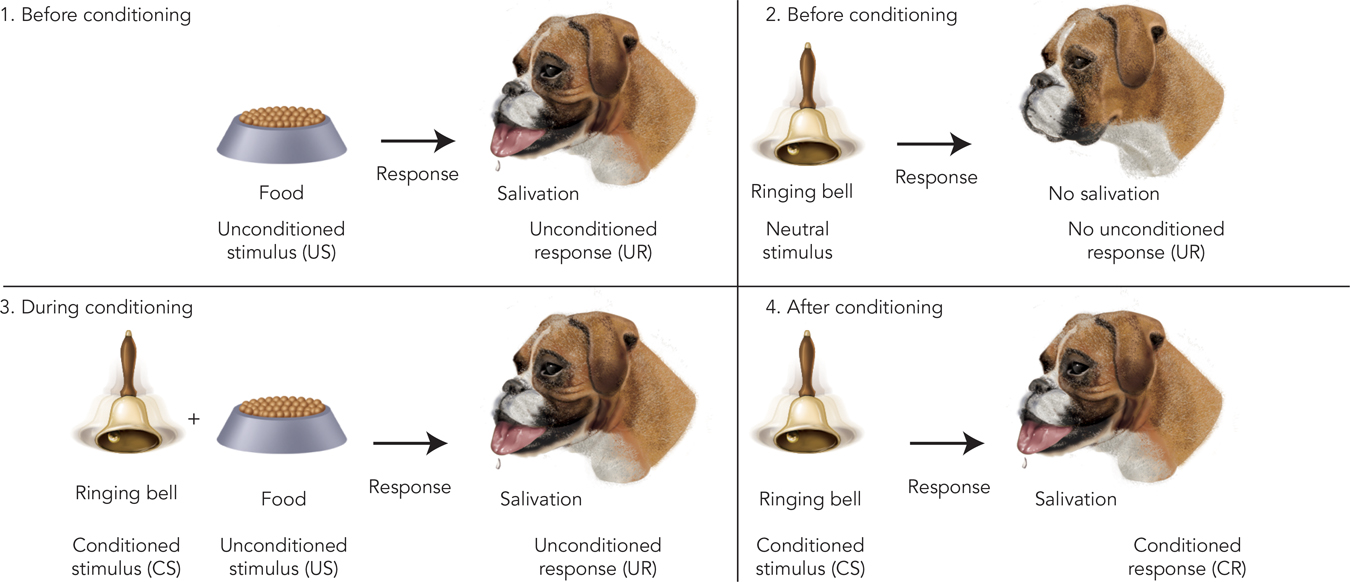
WHAT DO YOU KNOW?…
Question 2
Marnie had a toy called a “jack-
- US =
- UR =
- CS =
- CR =
Classical Conditioning Across the Animal Kingdom
Preview Questions
Question
 What types of organisms learn through classical conditioning?
What types of organisms learn through classical conditioning?
Question
 Why did a research participant known as Little Albert become afraid of a small white rat during the course of a psychology experiment, when the rat itself did nothing to make Albert afraid?
Why did a research participant known as Little Albert become afraid of a small white rat during the course of a psychology experiment, when the rat itself did nothing to make Albert afraid?
It’s not just dogs who learn through classical conditioning. All members of the animal kingdom do it. In principle, any organism might learn any association between any conditioned stimulus and any unconditioned stimulus. Let’s look at classical conditioning in simple organisms.
CLASSICAL CONDITIONING IN SIMPLE ORGANISMS. Even fruit flies can learn through classical conditioning. In research, fruit flies have been placed in containers with two different odors. In one of the containers, the flies receive a mild electric shock, whereas in the other container, they receive no shock. Later, researchers put the flies in a third container that has one of the odors on one end, and the other odor on the other end. What happens? They fly away from the odor previously paired with shock (Dudai, 1988). This means that this simple organism, a fruit fly, learned to associate the CS, odor, with the US, shock.
Another simple organism that learns through conditioning is the honeybee (Bitterman, 2006). Researchers placed honeybees in an area containing dishes of two different colors. Initially, the colors were neutral; honeybees didn’t prefer one to the other. The researchers then put a neutral stimulus (plain water) on one dish and an attractive US (a solution of water and sugar) on the other, and allowed the honeybees to fly to both dishes to learn what they contained. Later, researchers placed the honeybees in an area with empty dishes of the same two colors. Which color dish did the bees fly to first? They consistently flew to the color of dish that previously had contained the sugar solution. In other words, they learned that color, the CS, predicts sugar, the US.
What about more complex organisms? Let’s look at classical conditioning in organisms with the most complex brains of all: human beings.
CLASSICAL CONDITIONING IN HUMANS: EMOTION. Early in the twentieth century, an American psychologist, John Watson, read about Pavlov’s experiments and became intrigued. Could Pavlov’s research with dogs be extended to humans? To find out, he and a colleague, Rosalie Rayner, ran an experiment on the classical conditioning of human emotions. The emotion they studied was fear, and the human was an 11-
Watson and Rayner’s experiment featured two key items, in addition to Little Albert himself: a white rat, which served as a conditioned stimulus, and a steel bar that made a loud noise—
After observing Little Albert’s reactions to the two stimuli, the rat and the noise, Watson and Rayner combined the two. They took the rat out of a basket and banged on the steel bar just as they showed the rat to Albert. Albert startled and fell over (Watson & Rayner, 1920). Watson and Rayner then repeated the pairing of the CS and US (the rat and the noise) six more times. Each time, Little Albert startled, fell over, or cried.
Next came the critical trial. Watson and Rayner showed the rat to Little Albert without banging on the bar. What do you think happened? Now Albert was afraid of the rat. When he saw it, he cried, fell over, and crawled away from it as fast as he could (Watson & Rayner, 1920). Through classical conditioning, Little Albert had learned a new emotional reaction—

Note that Little Albert’s fear did not result from anything the rat did. Its behavior didn’t change. What changed is that Albert learned a CS–
THINK ABOUT IT
What was the experimental design in the Little Albert experiment? Was there, in fact, an experimental design? A control group? Might Albert have started crying just from the stress of being in a lengthy experiment with two strangers and loud noises?
Which of your fears might have been classically conditioned?
CLASSICAL CONDITIONING IN HUMANS: SELF-
In one self-
Another adult response that can be shaped by classical conditioning is sexual arousal. Conditioning can convert neutral stimuli into sexually arousing ones. In a study conducted with heterosexual men and women, the CS was a non-
Here’s the key point about these studies of flies, honeybees, Little Albert, self-

How do you feel about the possibility that conditioning can explain why you’re attracted to someone?
WHAT DO YOU KNOW?…
Question 3
If you rigged a cookie jar to emit an aversive noise every time your roommate opened it, his or her fear would initially be a(n) response, but after several pairings of the US () with the CS (), fear would become a response to seeing the cookie jar.
Five Basic Classical Conditioning Processes
Preview Questions
Question
 If you want to teach an animal to associate a conditioned stimulus with an unconditioned stimulus, about how long should you wait, after the conditioned stimulus, before presenting the unconditioned stimulus?
If you want to teach an animal to associate a conditioned stimulus with an unconditioned stimulus, about how long should you wait, after the conditioned stimulus, before presenting the unconditioned stimulus?
Question
 In classical conditioning, if you slightly alter the conditioned stimulus that an animal previously has learned to associate with an unconditioned stimulus, what happens?
In classical conditioning, if you slightly alter the conditioned stimulus that an animal previously has learned to associate with an unconditioned stimulus, what happens?
Question
 In classical conditioning, what is extinction?
In classical conditioning, what is extinction?
Question
 What happens when a stimulus that normally produces a response in an organism is presented over and over again?
What happens when a stimulus that normally produces a response in an organism is presented over and over again?
Question
 How does research on compensatory responses explain some cases of drug overdose?
How does research on compensatory responses explain some cases of drug overdose?
You’ve learned the basic fact of classical conditioning: Once organisms associate a conditioned stimulus with an unconditioned stimulus, the previously neutral CS evokes the same type of response as did the US. Yet there’s more to learn. Pavlov and later researchers investigated five key aspects of the learning process: acquisition, generalization, extinction, habituation, and compensatory responses.
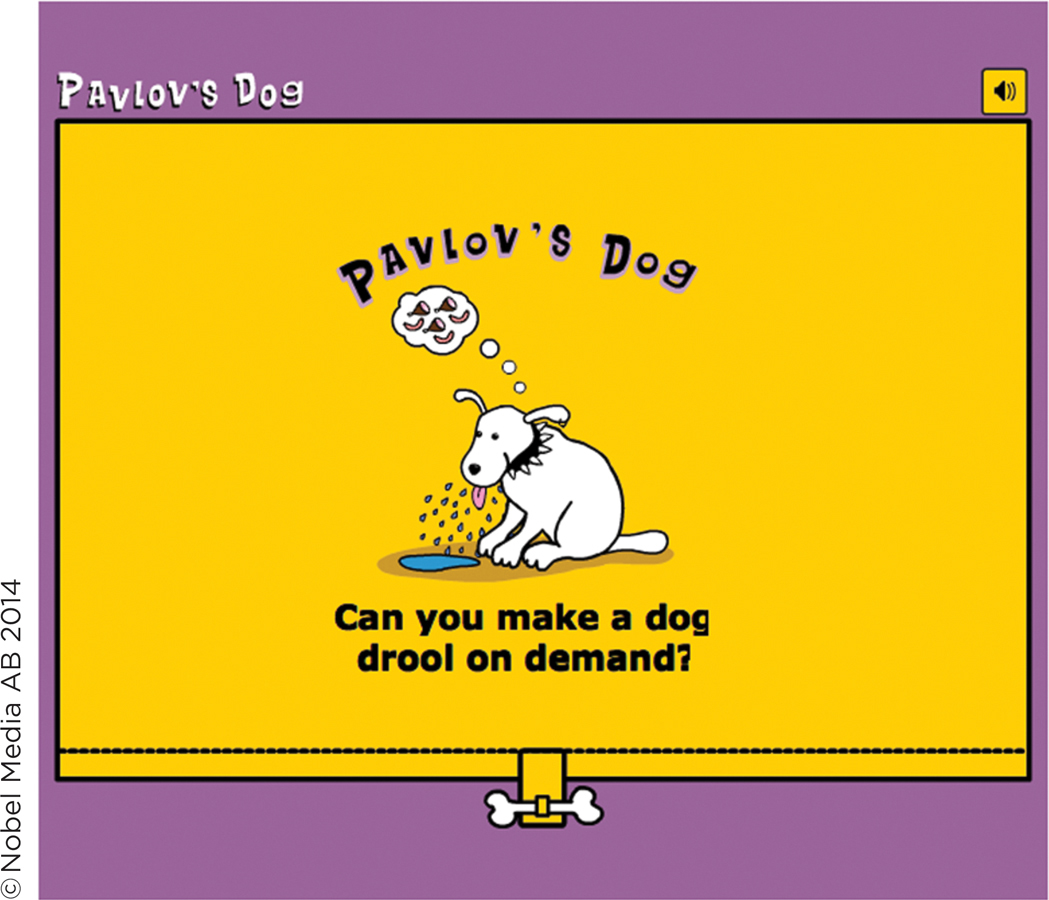
ACQUISITION. In the study of learning, acquisition is attaining the ability to perform a new response; after learning, the organism is said to have “acquired” the response. When Pavlov’s dogs first salivated (the CR) upon hearing a bell (the CS), or Lizzy first responded fearfully (the CR) when hearing the name “Elizabeth” (the CS), the CR had been acquired.
Research has answered three basic questions about the acquisition of conditioned responses. The first is, if you want an organism to quickly acquire a CR, how long should you wait after presenting the CS, before presenting the US?
Try to answer this for yourself. Imagine Pavlov’s lab: To get an animal to learn, you ring the bell (the CS) and then wait—
If you answered, “not long at all,” you’re right! You should present the food almost immediately after ringing the bell. If you wait longer—

A second finding in the study of acquisition shows that animals have a keen sense of time. They learn not only that the CS predicts the US, but also the amount of time that transpires between the two (Savastano & Miller, 1998). Animals learn to respond to the CS at exactly the point in time in which the US is most likely to appear. For example, when the CS is a tone, the US is a puff of air to the eye, the UR is an eyeblink (caused by the air puff), and the duration between the CS and US is half a second, animals will learn to close their eyes precisely half a second after they hear the tone (Gluck, Mercado, & Myers, 2008).
A third question is whether animals learn to associate the CS and US gradually or suddenly. If an animal learned gradually, it might respond slightly to a CS after 10–
Research shows that animals suddenly “get it.” Within just a few trials, they change abruptly from a state in which they do not respond to the CS to one in which they respond to it strongly and consistently (Gallistel, Fairhurst, & Balsam, 2004). Although psychologists have been studying learning for more than a century, only relatively recently have they come to appreciate the sudden manner in which organisms acquire a new response.
In summary, research on acquisition shows that (1) organisms will best acquire the ability to respond to a CS if the duration between CS and US is brief; (2) they will learn to respond precisely when the US is most likely to occur; and (3) they will learn all this quickly, rapidly transitioning from no response to a full response to the CS.
GENERALIZATION. In Pavlov’s experiments, dogs learned to salivate when a bell rang. What do you think would have happened if Pavlov changed bells—
It turns out that when you change bells—
You’ve already seen two cases of generalization. Little Albert’s fear generalized: He became afraid not only of the white rat, but also of other white or furry objects—
Generalization occurs systematically. Stimuli that vary more and more from the original CS elicit less and less of a CR (Bower & Hilgard, 1981; Figure 7.4). You saw this, too, in the opening story; the boy was less fearful of metal buttons than plastic ones. Laboratory experiments document generalization. In one study (Lissek et al., 2008), conditioning trials paired pictures of geometric rings (neutral stimuli) with uncomfortable electric shocks (USs). Participants later viewed pictures of other rings whose sizes varied systematically from the rings that were shown originally. Classically conditioned fear generalized to rings of other sizes. And as the depicted rings increasingly departed in size from the original ones, participants’ physiological responses became weaker.
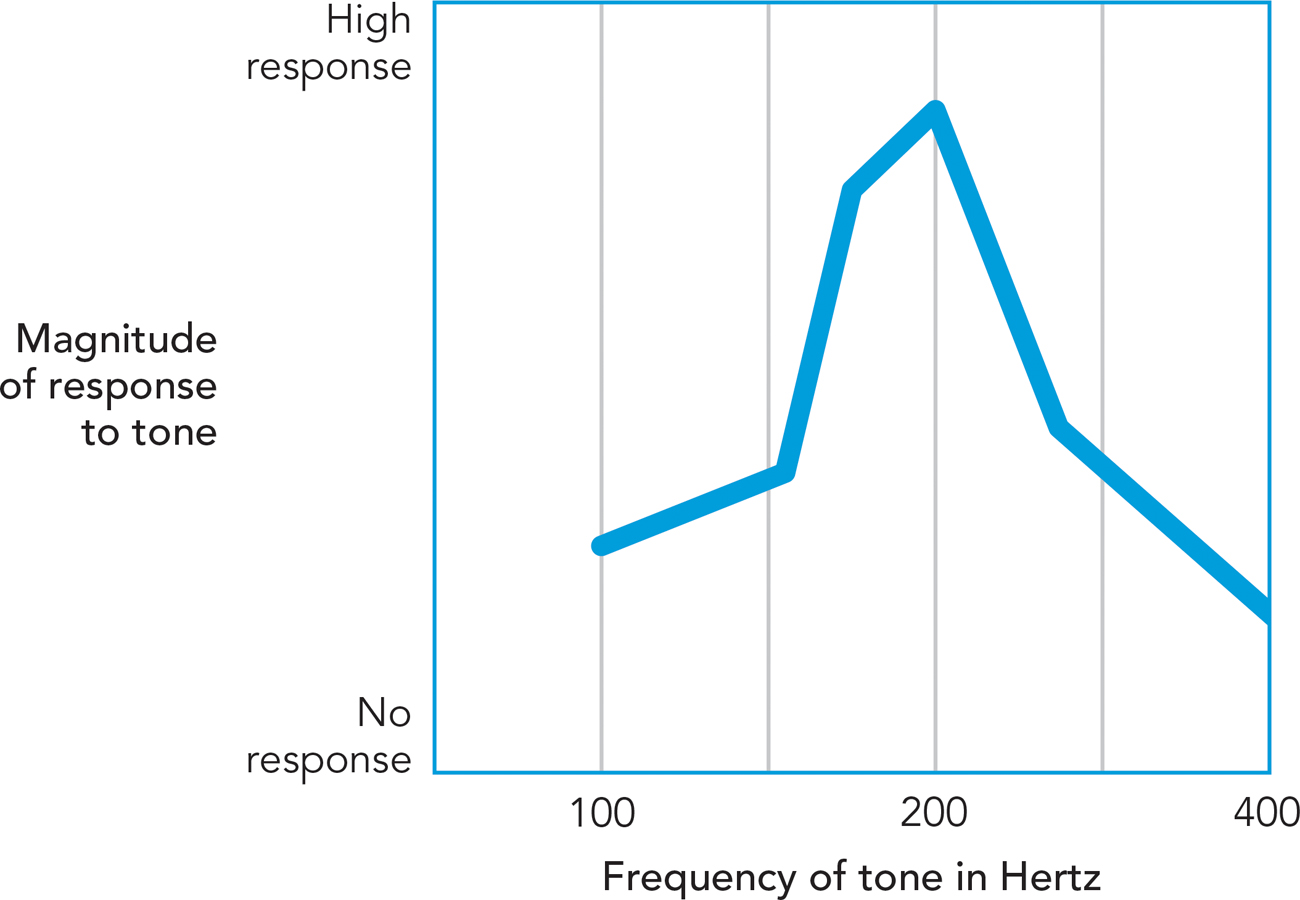
Generalization explains experiences that otherwise would be puzzling. Consider the case of Pearson Brack, a bombardier in World War II. After a series of successful flights, Brack developed a strange symptom. When he saw from the plane’s altimeter that he had ascended to 9000 feet, he started to become uncontrollably anxious: He trembled, turned pale, and started breathing rapidly. Once the plane descended a few hundred feet, he was fine. But if it ascended again, he became anxious again, with the anxiety increasing as it reached 10,000 feet, at which point Brack would faint. What was the cause? It couldn’t be the altitude itself; other crew members felt fine and Brack previously had flown at these altitudes.
A psychological analysis suggested that the cause was classical conditioning (Mischel, 1968). The reading of 10,000 feet had become a conditioned stimulus that triggered panic. Lower altitudes triggered lower levels of anxiety, due to generalization. Key evidence for this conclusion was that, on the mission before his symptoms began, enemy fighters attacked Brack’s plane. It rolled, dove uncontrollably, and almost crashed. Brack sustained an injury in the turmoil. The attack likely occurred while Brack’s plane was flying at exactly 10,000 feet. That altitude, then, was paired with a US (the attack) and thus became a powerful CS, with effects that generalized to nearby altitudes.
THINK ABOUT IT
Does Pavlov’s classical conditioning approach explain Pearson Brack’s fear? Or might there be additional relevant psychological processes—
Responses do not generalize to all stimuli. Organisms discriminate between stimuli. Discrimination in classical conditioning is a learning process in which organisms respond to one stimulus but not another. If, for example, Pavlov had trained a dog using a bell as a CS and then had switched stimuli—
Think of an object to which you have a classically conditioned fear response. To what other objects might you generalize this response?
EXTINCTION. What do you think would happen, after conditioning, if a researcher kept ringing the bell, but there was never another trial in which the dog received food? Would the dog salivate to the bell, trial after trial, forever? No, it wouldn’t. What actually happens is extinction. In classical conditioning, extinction is a gradual lessening of a conditioned response when a CS is presented repeatedly without any presentations of the US. When a CS occurs repeatedly but the US does not follow, organisms gradually display less and less of the conditioned response. Eventually, they stop responding altogether; the CR becomes extinct. Your dog eventually would stop salivating when you rang the bell if there was no more food. Little Albert’s fear would eventually have extinguished if Watson and Rayner had repeatedly presented the rat without ever again banging on the steel bar.
Interestingly, when extinction occurs, it does not mean that an organism has completely forgotten the CS–
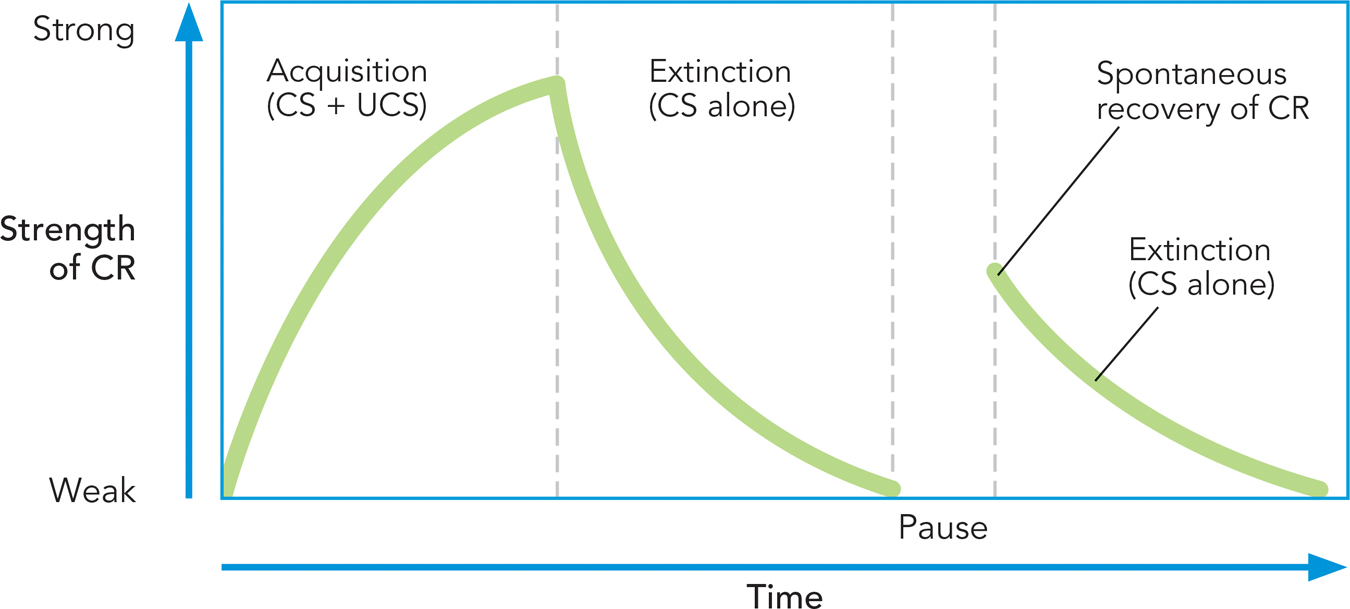
What is a classically conditioned response you wish would become extinct?

Humans, too, exhibit spontaneous recovery. A study of fear conditioning among college students shows how this works (Huff et al., 2009). The study had three main steps:
Conditioning trials paired an electric shock, a US, with pictures of snakes or spiders, the CS. After this conditioning, but not before, students reacted fearfully to the pictures.
Next, extinction trials presented the CS without the US; that is, the photos were shown, but there was no electric shock. These extinction trials eliminated students’ fearful reactions to the pictures.
Page 270Finally, the next day students returned to the lab and were shown the snake or spider pictures again. Their fearful reactions returned; they reacted fearfully to the pictures despite the previous day’s extinction trials. The students exhibited spontaneous recovery (Huff et al., 2009).
CONNECTING TO THE BRAIN AND TO PSYCHOTHERAPY

HABITUATION. The fourth conditioning process, habituation, differs from the previous three (acquisition, generalization, and extinction) in that it does not involve pairing a CS and US. Instead, habituation is a change in behavior that occurs when one stimulus, which normally evokes a response in an organism, merely is presented repeatedly. The organism’s response to the stimulus gradually lessens; in colloquial terms, it “gets used to” the stimulus.
Habituation occurs all the time. On a cold winter day when you first put on a coat, it may feel heavy. Not long afterward, you barely notice that you’re wearing it; you habituate to the coat’s weight. If you’re in a room with a noisy air conditioning or heating system, you might notice the noise at first, but eventually you become unaware of it. You habituate to the sound. If you move from a rural area to a city, you may at first be bothered by the around-
In summary, research on acquisition, generalization, extinction, and habituation yielded consistent results. Pavlov’s research findings meant that a wide range of responses (in a wide range of organisms, and in both the laboratory and everyday life) could be understood in terms of a small set of learning principles.

COMPENSATORY RESPONSES AND DRUG TOLERANCE. Besides learning that a CS predicts a US, animals also do something else. They learn to prepare for the anticipated effects of the US. Once they learn that a CS signals an imminent US that will affect them physiologically, their bodies automatically respond in a manner that prepares them for this effect. This preparation is called a compensatory response. Compensatory responses are biological reactions that are the opposite of the effects of a stimulus and thereby attempt to counterbalance those effects (Siegel, 2005; Siegel & Ramos, 2002).
In their research, Pavlov’s colleagues gave dogs injections of adrenalin, a drug that increases heart rate. When they did this repeatedly, they found that the drug gradually had less and less of an effect on heart rates. The dogs, it appeared, had developed physiological reactions that counteracted the effects of the drug. To test this idea, researchers placed the dogs in an area of the lab where they usually received the adrenalin injections, but gave them an injection of a neutral substance rather than adrenalin. In response, the dogs’ heart rates decreased. When the dogs experienced the conditioned stimuli (the area of the lab, the injection needle) that normally signaled the presentation of a drug that increased heart rate, they automatically reduced their heart rate to compensate for the anticipated effects of the drug (Siegel & Ramos, 2002).
This conditioning research on dogs is directly relevant to humans. People exhibit drug tolerance, reacting less and less to a fixed amount of a drug. The compensatory response discovered by researchers directly contributes to this reduction in drug effects (Siegel, 2005). When people take a drug repeatedly, their bodies automatically produce biological responses that counteract the drug’s effects. As a result, they need higher amounts of the drug to obtain a given level of drug effectiveness.
Compensatory responses are situation-
The situation-
Such overdoses can even occur with prescription drugs. Siegel and Ellsworth (1986) report the case of a cancer patient taking morphine for pain relief. He usually received the drug in the same situation: his dimly lit bedroom. One day, he happened to take the same amount of the drug in a different setting—
In summary, organisms can tolerate different amounts of a drug in different situations. A drug may produce modest effects in one situation, but large effects in another.

WHAT DO YOU KNOW?…
Question 4
Match the key aspect of the learning process on the left with its description to the right. In this context, imagine you had acquired a classically conditioned fear of German Shepherds when you were bitten by one owned by your neighbor.
1. Generalization 2. Extinction 3. Habituation | Your neighbor’s German Shepherd barks all day and you grow so accustomed to hearing the barking, you lose your fear of him. You fear other large dogs as well, especially ones that look like German Shepherds. Several years have passed and you have not been harmed by German Shepherds, so walking by your neighbor’s dog no longer elicits fear (though the fear could spontaneously recover). |
CULTURAL OPPORTUNITIES
Learning to Like Food
How do the following dishes sound?
Duck blood soup (main ingredient: the blood of a freshly killed duck)
Deku Delight (main ingredient: smoked and pan-
fried rats) Chipotle-
Mescal salsa with roasted locusts (instructions: “Garnish the salsa with locusts and serve with nacho chips”)
Maybe they don’t sound so good to you. But food preferences vary across cultures. What is tasty home cooking in one culture is disgusting and inedible in another. Sure, you might not eat duck blood soup. But people from other cultures may hesitate to eat a breakfast of grain products drenched in yellow 5, yellow 6, red 40, and blue 1 (food dyes common in U.S. breakfast cereals).
How, then, do people learn to eat such a wide variety of foods? They do so, at least in part, through classical conditioning. The conditioning process creates a learned connection between foods’ (1) nutrients and (2) appearance and flavor.
When people are hungry, the nutrients in food are unconditioned stimuli (USs). Automatically, without any learning, the nutrients reduce hunger and increase energy. Hunger reduction and energy increase thus are unconditioned responses (URs) triggered by the US.
Foods have not only nutritional value, but also appearance and flavor. When people eat a food, its appearance and flavor are paired with its nutritional value, the US, and thus become conditioned stimuli (CSs). Thanks to this pairing of flavor/appearance with nutrition, people learn to like a food’s appearance and flavor—
This classical conditioning analysis makes an interesting prediction. If people eat a new food when they are not hungry, then they should not develop a liking for that food. This is because, when one is not hungry, eating will not trigger the UR (needed energy increase and reduced hunger).
Researchers have tested this prediction with a cleverly designed experiment (Appleton, Gentry, & Shepherd, 2006). First, they combined plain yogurt with exotic spices to create four yogurts with unusual flavors that research participants had never tasted before. They then asked participants to try two of the yogurts at specific times during the day, when their body had high energy requirements (just before lunch and dinner, when participants were hungry), and to sample the other two at a time of low energy requirements (just after breakfast or lunch). Later, participants indicated which yogurts they liked best. People liked the yogurts they had eaten when they were hungry better than those they had eaten when they were not hungry (Appleton et al., 2006). The results were exactly as predicted by the classical conditioning analysis. Participants developed a preference for flavors (CSs) that were associated with the body receiving needed energy (a UR).
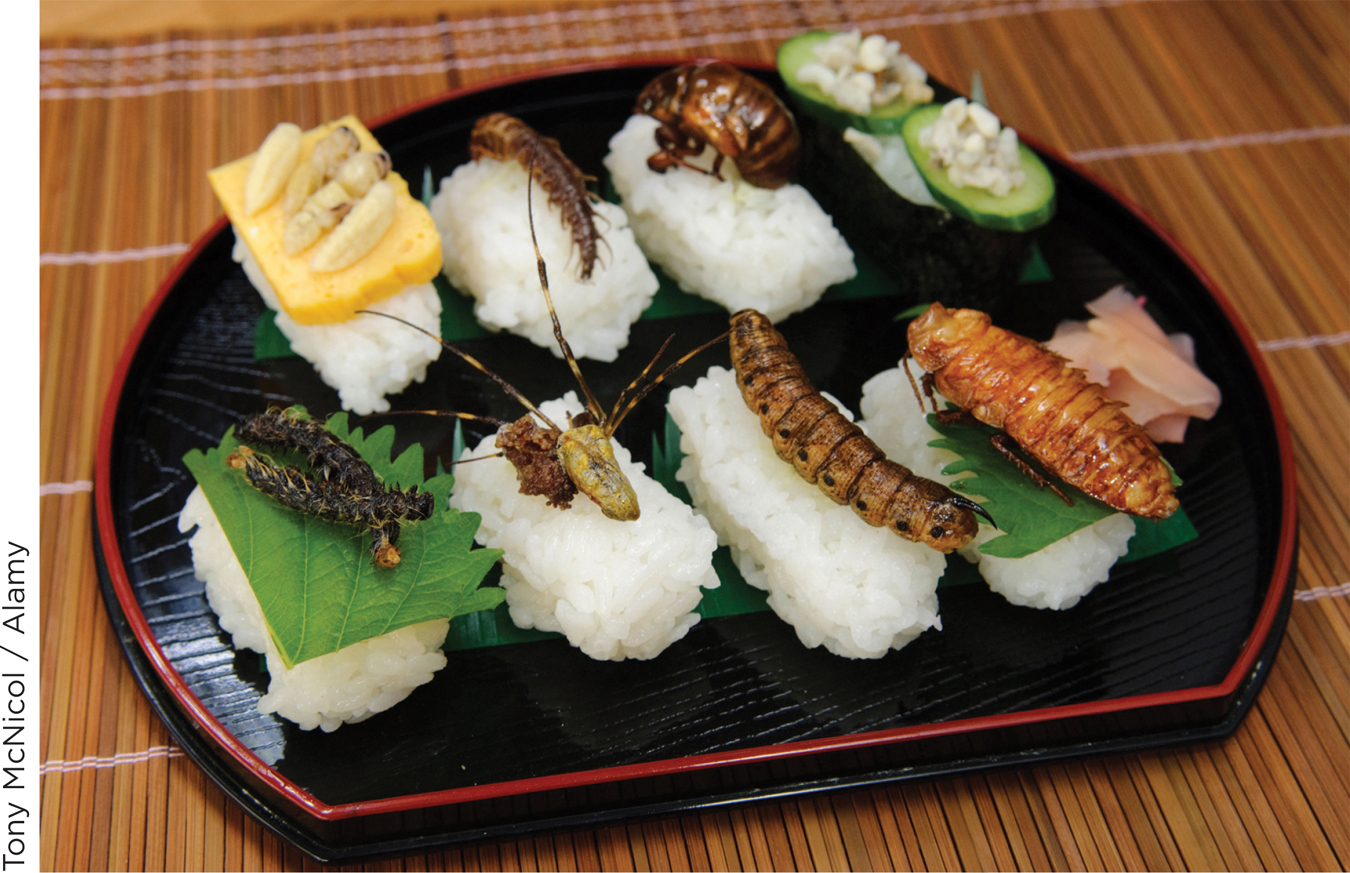
WHAT DO YOU KNOW?…
Question 5
People who do not live in New Jersey may have trouble understanding the appeal of Taylor Ham (a.k.a. pork roll), a salty and fatty breakfast meat often enjoyed on a hard roll with cheese. Many from New Jersey, however, have developed a classically conditioned preference for it. For this example, identify the US, UR, CS, and CR.
US =
UR =
CS =
CR =
UR = hunger reduction/ increase in energy;
CS = appearance/flavor of pork roll;
CR = hunger reduction/increase in energy
Beyond Pavlov in the Study of Classical Conditioning
Preview Questions
Question
 What is blocking and how did the discovery of blocking alter psychologists’ understanding of the processes involved in classical conditioning?
What is blocking and how did the discovery of blocking alter psychologists’ understanding of the processes involved in classical conditioning?
Question
 What happens when animals learn that they cannot control unpleasant outcomes they wish to avoid?
What happens when animals learn that they cannot control unpleasant outcomes they wish to avoid?
Question
 How does conditioned taste aversion (the Garcia effect) provide information about the role of evolution and biology in classical conditioning?
How does conditioned taste aversion (the Garcia effect) provide information about the role of evolution and biology in classical conditioning?
Question
 Through what research strategy have scientists succeeded in identifying the biological bases of classical conditioning?
Through what research strategy have scientists succeeded in identifying the biological bases of classical conditioning?
Pavlov’s work did have limitations. Later researchers sometimes made discoveries that were inconsistent with Pavlov’s original findings. Let’s look at three of them—
ACQUIRING NEW INFORMATION. Pavlov believed that if a CS is paired with a US, animals always will learn to associate the two. It turns out, however, that sometimes they don’t. They only learn to associate a CS with a US if that CS provides new information about a US, that is, information the animal did not have previously.
We know this from research on blocking. In blocking, animals fail to learn that a CS predicts a US if they already can predict the US based on other cues (Rescorla, 1988). Their prior knowledge blocks the learning of new CS–
In blocking research (Kamin, 1968), researchers first exposed animals to a series of trials in which one CS, a sound, predicted the occurrence of the US, a shock. Next, animals experienced a second set of trials in which two stimuli, the sound plus a light, predicted the same US. Researchers then examined whether animals would respond when only the second stimulus, the light, was presented. Pavlov thought they would—
Blocking research shows that classical conditioning is more complex than Pavlov thought. Animals don’t merely learn simple associations between two stimuli. They acquire information about their environment as a whole (Rescorla, 1988). When they already have enough information—
LEARNED HELPLESSNESS. Pavlov showed that animals learn when two events (the occurrence of a CS and a US) are related. Later research showed that animals also can learn when two events are not related. When they learn that (1) aversive outcomes are not related to (2) their own behavior—
In classic learned helplessness research (Maier & Seligman, 1976; Figure 7.6), dogs were placed in a box with two sides separated by a barrier that they could easily jump over. Experimenters placed a dog in one side of the box and then administered an electric shock to that side. Dogs quickly escaped the shock by jumping over the barrier. In so doing, they learned that their behavior (jumping over the barrier) could control the outcome (avoid the shock).

Then, with a different group of dogs, the experimenters introduced an additional procedure at the outset of the experiment. Before entering the box, these dogs experienced a series of electric shocks that they could not avoid. Next, they entered the box and received the shocks that were easily avoidable by jumping over the barrier. Unlike the first group of dogs, this second group never figured out how to avoid the shocks. Instead of running around and trying to jump over the barrier when the shocks were administered, as the first group of dogs did, this second group just gave up. They lay down passively on the floor while the shocks were administered.
The second group of dogs experienced learned helplessness. The researchers concluded that the dogs’ experience with uncontrollable shocks caused them to expect that shocks and their own behavior were unrelated. This, in turn, caused them to respond helplessly: to not even try to escape the later shocks, which they easily could have avoided (Maier & Seligman, 1976).
In what situations does it seem like you can’t do anything to control your outcomes?
Though conducted with dogs, this research has profound implications for humans. Life often seems like it can’t be controlled. You try to lose weight, but fail. You ask people out on a date, and they say no. You apply for jobs, and don’t get them. When this happens, there’s a risk: You might wrongly conclude that nothing you can do will work—
Psychologists have developed interventions to combat this risk. One was designed for first-
This simple intervention worked. Compared with students in a control group who did not receive it, students who received the anti-
BIOLOGICALLY RELEVANT STIMULI AND CONDITIONED TASTE AVERSION. Another finding that moves beyond Pavlov’s work involves conditioned taste aversion, the rapid learning of a connection between food (specifically, the taste of a food) and illness that occurs after consuming that food (Garcia & Koelling, 1966). Organisms learn very speedily that the food is a CS that signals the UR, illness. Conditioned taste aversion is also called the Garcia effect, in honor of the researcher who discovered it, John Garcia.
Have you ever eaten some unusual dish, gotten sick, and then decided never to eat it again? (This happened to your author once in college; I haven’t eaten moussaka, a Greek casserole dish, ever since.) It sounds like a simple case of classical conditioning: Sickness is the UR, the unusual food is the CS, and you learn to associate the two. In some ways, conditioned taste aversion is similar to other cases of classical conditioning; for example, as in other forms of conditioning, the CR generalizes (from the food flavor with which conditioning occurred to similar flavors; Richardson, Williams, & Riccio, 1984). Yet the example of conditioned taste aversion does not fit the traditional Pavlovian conditioning paradigm in three respects:
You associated food and illness after only one learning trial, unlike the usual Pavlovian paradigm, where multiple trials are required for an organism to learn a new response.
You learn the connection even though a significant period of time separates the CS (the food) and the UR (the sickness). In typical conditioning experiments, the US must rapidly follow the CS (see Figure 7.3).
You avoid the food, but, unlike what Pavlov might have predicted, you don’t avoid other stimuli that also predicted illness, such as the fork you used to eat the food or the location you were in when you first began to feel sick. (Your author did not forever avoid the college cafeteria after eating the moussaka.)
What’s different about the association of food and sickness? Garcia recognized that the difference lies in organisms’ evolution. Across the course of evolution, some CS–
Garcia’s findings opened the door to research on how a species’ evolutionary past affects its ability to learn in the present (Domjan & Galef, 1983). Seligman (1970) has suggested that the link between the evolutionary past and contemporary learning can be understood with the concept of preparedness. Preparedness refers to the ease with which an organism can learn to associate a stimulus and response. Thanks to evolutionary pressures, some stimulus–
In sum, contemporary research has moved beyond Pavlov in a number of ways. Researchers now understand that organisms acquire information about the overall nature of their environment, that this information includes cases in which stimuli and responses are unconnected, and that some links between stimuli and responses are easier to learn than others, thanks to predispositions that organisms acquired over the course of evolution.
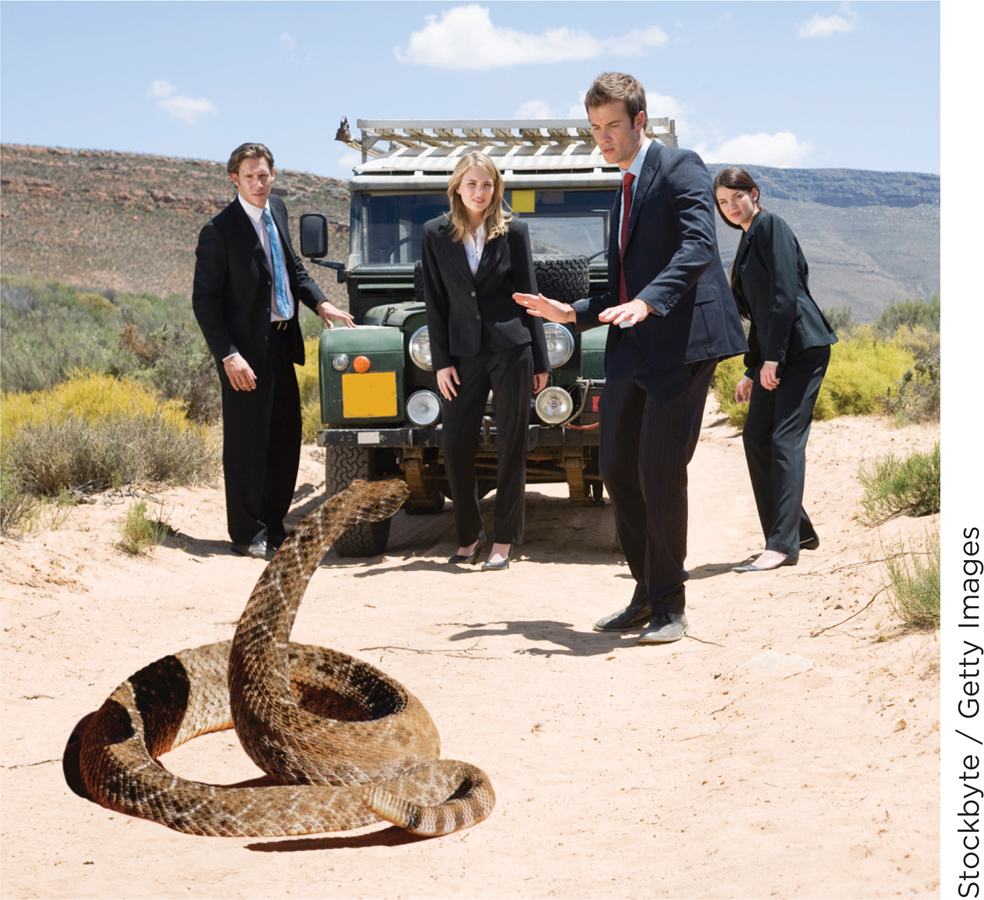
These advances are important, but they do not overturn basic foundations laid by Pavlov more than a century ago. Through the psychological processes of classical conditioning, a wide spectrum of organisms learns new responses to the environment when encountering stimuli that predict one another. These psychological findings prompt contemporary researchers to seek the biological bases of conditioning processes, as you’ll see now.
WHAT DO YOU KNOW?…
Question 6
True or False?
If you failed to notice that a loud fire alarm was accompanied by a flickering light, you might be experiencing blocking because the CS (alarm) would be enough to predict the US (fire).
A. B. Learned helplessness is at work when we learn that the only thing that can control outcomes is our own behavior.
A. B. The Garcia effect runs counter to traditional Pavlovian conditioning because, in it, conditioning can occur even after one pairing of the CS and US; and even though you don’t learn to avoid other stimuli, that also could predict the US.
A. B.
Biological Bases of Classical Conditioning
Preview Question
Question
 What happens at the level of the nervous system when an animal experiences habituation?
What happens at the level of the nervous system when an animal experiences habituation?
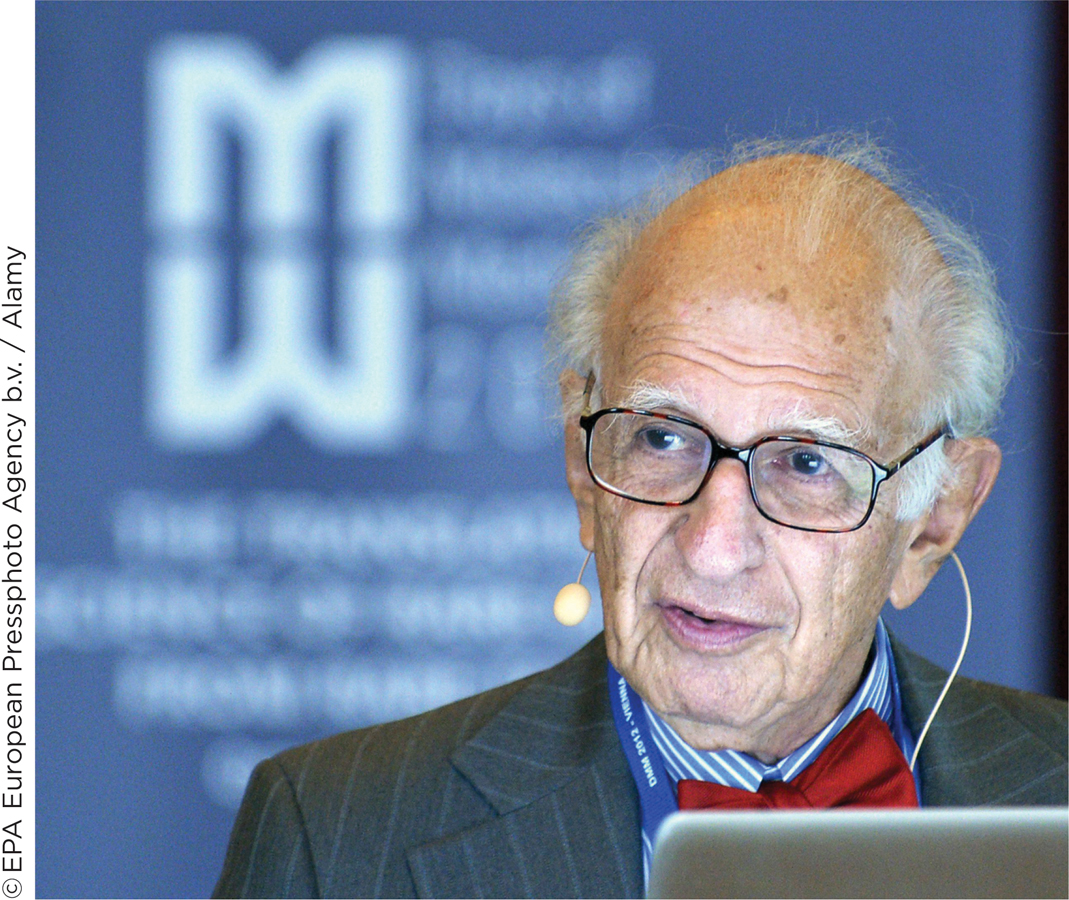
The human brain contains billions of neurons (see Chapter 2). Each one of them communicates to a large number of other neurons through neurotransmitters—
One way is to study a simpler nervous system possessed by an organism with far fewer neurons than a human being. The neuroscientist Eric Kandel (2006) has identified biological bases of learning by studying a very simple animal, Aplysia.
Aplysia are sea slugs—
In one line of research (reviewed in Kandel, Schwartz, & Jessell, 2000), Kandel and colleagues identified the nervous-
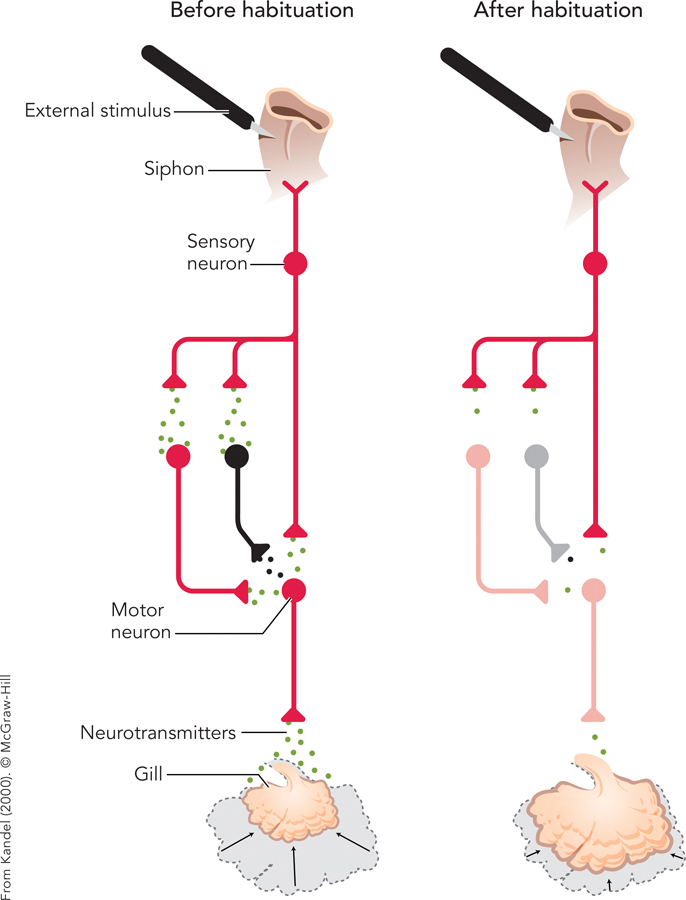
Kandel’s research fulfills the promise formulated by Pavlov. The great Russian scientist anticipated that the psychology of learning could be explained in terms of the biology of the nervous system. By discovering biological mechanisms of classical conditioning in the Aplysia, Kandel has taken a critical step toward achieving this goal. More research is needed; it is a large step from the nervous system of sea slugs to the brains of humans. Nonetheless, Kandel’s research begins to provide psychology with a complete, three-
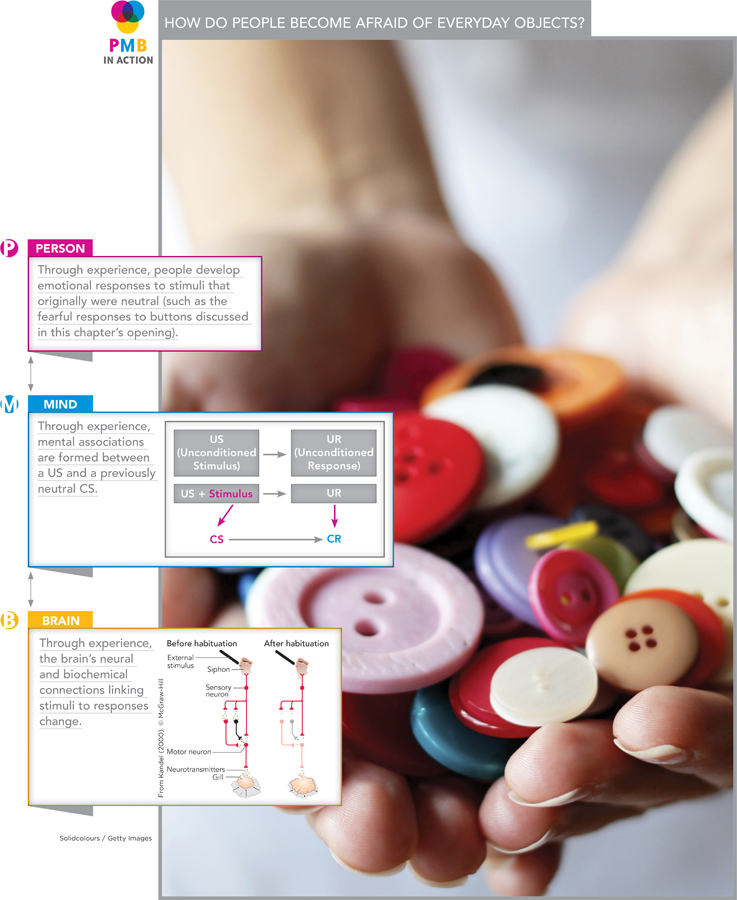

WHAT DO YOU KNOW?…
Question 7
An Aplysia will reflexively withdraw its gill in response to a stimulus. However, if an object touches the gill repeatedly, the Aplysia habituates, or “gets used to,” the stimulus and stops retracting its gill. What is the stimulus-
TRY THIS!
Before you read about a second form of learning, operant conditioning, see it in action. Go to www.pmbpsychology.com and try your hand at this chapter’s Try This! activity. It tests your skill in teaching an animal to learn through operant conditioning. When you’re finished, come back to the chapter, where you will learn about the scientific principles that are built into the activity. ![]()